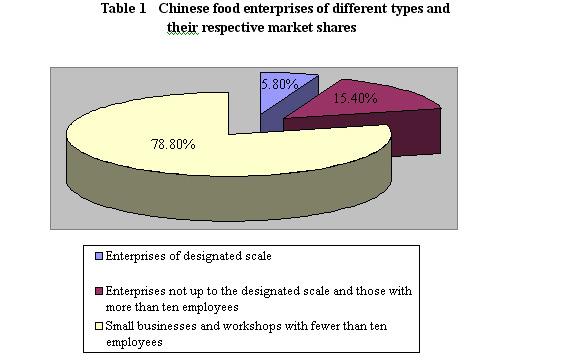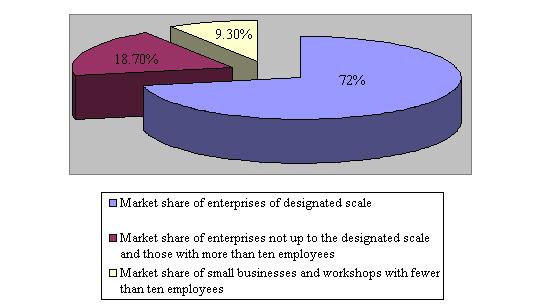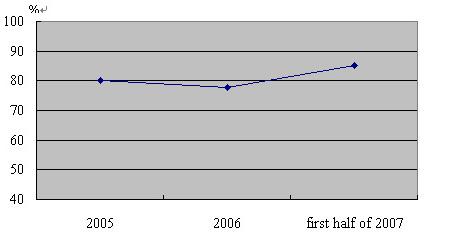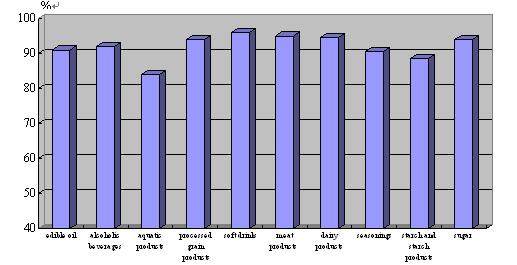| The White Paper on the Quality and Safety of Food in China | |
|---|---|
| Sep 16, 2007 02:52 | |
 | Recently, the issue of Chinese food safety and quality has been on the international spotlight. The foreign media fired fierce attack against Chinese food quality. However, this is outside report. I have been wondering how the Chinese goverment defend the issue of food safety and quality. I tried very hard to find this white paper. Here, share with you. Source:http://www.china.org.cn/ The Quality and Safety of Food in China Contents I. Food Production and Food Quality II. Food Safety Regulatory System and Work III. Supervision of Imported and Exported Food IV. Law Regime and Technological Guarantee System for Food Safety V. International Exchanges and Cooperation Regarding Food Safety Information Office of the State Council of the People's Republic of China August 17, 2007, Beijing |
| Sep 16, 2007 02:53 | |
 | I. Food Production and Food Quality The quality and safety of food is a major benchmark of the economic development and people's living conditions of a country. Adhering to the people-oriented approach, the Chinese government has always attached great importance to food quality and safety. Moreover, sticking to the principle of nipping problems in the bud, it has built and improved a supervisory system and mechanism for food safety, strengthened legislation and the setting of relevant standards, exercised strict quality control regarding food, actively promoted international exchanges and cooperation in this respect, and has greatly raised public awareness of food safety. Thanks to such efforts, the overall level of food quality in China is being steadily enhanced, the situation of food safety is continuously improving, and the order in food production and operation have markedly turned for the better. |
| Sep 16, 2007 02:54 | |
 | I. Food Production and Food Quality 1. The Quality and Safety Level of Processed Food Is Steadily Improving (1) Rapid and Sound Development of the Food-processing Industry In recent years, China's food industry has maintained fast and sound growth, with a steady increase in economic benefits. Foodstuffs can be classified by their raw materials and processing techniques into 525 kinds in 28 categories: processed grain products; edible oil, fat and fat products; seasonings; meat products; dairy products; soft drinks; convenient food; biscuits; canned food; iced drinks; fast-frozen food; potato and dilated food; candies (including chocolate and chocolate products); tea; alcoholic beverages; vegetable products; fruit products; roasted seeds and nuts; egg products; cocoa and bakery coffee products; sugar; processed aquatic products; starch and starch products; pastries; bean products; bee products; special diet food, and others. At present, China has 448,000 enterprises engaged in foodstuff production and processing. Among them, 26,000 enterprises of designated scale 1 occupy 72 percent of the market, taking the leading role in terms of output and sales revenue; 69,000 are enterprises not up to the designated scale and those with more than ten employees, taking up a market share of 18.7 percent; and 353,000 are small businesses or workshops with fewer than ten employees, with a market share of 9.3 percent. (See Table 1) |
| Sep 16, 2007 02:57 | |
 | Refering to private industrial enterprises with annual revenue of two million yuan or more and all state-owned industrial enterprises, as well as private commercial enterprises with annual revenue of five million yuan or more and all state-owned commercial enterprises. — Tr. |
| Sep 16, 2007 03:00 | |
 | Pie Chart |
| Sep 16, 2007 03:02 | |
 | Statistics show that, in 2006, industrial food enterprises of designated scale generated 2,158.695 billion yuan of output value (excluding tobacco), accounting for 6.8 percent of the national industrial output value, and up 23.5 percent year on year. The average annual industrial added value and profit of processing enterprises of grain, oil, meat and dairy products all exceeded 20 percent. The output of major foodstuffs in 2006 were: wheat flour, 51.93 million tons; edible vegetable oil, 19.855 million tons; fresh frozen meat, 11.125 million tons; dairy products, 14.596 million tons; beer, 35.152 million kl; and soft drinks, 42.198 million tons. These figures show rises of 28.2 percent, 17.5 percent, 24.0 percent, 23.5 percent, 14.7 percent and 21.5 percent year on year, respectively. In the first six months of 2007, the accumulated output value of the food industry amounted to 1,281.62 billion yuan, up 29.9 percent as compared with the corresponding period last year. The output of beer, edible oil, soft drinks and gourmet powder led the world. |
| Sep 16, 2007 03:03 | |
 | At present, the development of China's food industry displays the following features: One, the processing techniques and equipment of some food enterprises reach or approach the advanced international level. Large meat, dairy product, beverage and beer producers all have world first-class production and testing facilities, which guarantees the quality of their products. The development and application of such key processing techniques as membrane-separation technology, physical property modification, cold-aseptic filling, concentration and cold processing has narrowed China's gap with the world advanced level in terms of processing technology and equipment. Two, quality control of the enterprises has become more scientific and standard. So far, 107,000 food producers have obtained market access permits regarding quality and safety, and 2,675 have been granted hazard analysis and critical control point (HACCP) certificates. Three, the structure of products is being improved to cater to the increasingly diverse demands of consumers. The proportion of intensively or deeply processed foodstuffs to the total output of foodstuffs keeps increasing. For instance, liquid dairies now account for more than 85 percent of the total output of dairy products; colas no longer dominate the market, as a result of the mushrooming of packed drinking water and fruit, vegetable and tea drinks; special flour above second grade accounts for 65 percent of the total output of wheat flour; standard rice above first grade accounts for 88 percent of the total output of rice, and special rice for 33.9 percent of the total output of rice; and Grades I and II oil (salad oil and quality culinary oil according to previous national standards) accounts for 58.5 percent of the total output of edible vegetable oil. |
| Sep 16, 2007 03:05 | |
 | 2) Continuous Improvement of Food Quality One, the acceptance rate of foodstuffs on the whole is steadily rising. The rate was 77.9 percent in the 2006 national foodstuffs sample survey, and it rose to 85.1 percent in a similar survey in the first half of 2007. The level of food quality and safety remains stable, with a gradual upturn. (See Table 2) Table 2 Acceptance rate of foodstuffs in sample surveys from 2005 to June 2007  |
| Sep 16, 2007 03:06 | |
 | Two, the quality of food produced nationwide is improving. In the first half of 2007, the 31 provinces, autonomous regions and municipalities directly under the Central Government on the mainland of China reported an average 89.2-percent acceptance rate of foodstuffs, and the figure in 14 of them surpassed 90 percent. Three, the quality of food in key sectors is fairly high. Thanks to the country's endeavors to improve the work of food producers and processors, the quality of 525 kinds of foodstuffs in 28 categories has been enhanced to various degrees, with remarkable progress in the quality of food with a large daily consumption. According to statistics, the ten foodstuffs with the largest consumption are edible oil, fat and fat products; alcoholic beverages; aquatic products; processed grain products; soft drinks; meat products; dairy products; seasonings; starch and starch products; and sugar. In the first half of 2007, sample surveys showed a 90-percent or higher acceptance rate of all the above ten foodstuffs except aquatic products, whose acceptance rate was 85 percent. That of meat products was 97.6 percent. (See Table 3) |
| Sep 16, 2007 03:08 | |
 | Table 3 Acceptance rate of the ten most-consumed foodstuffs in the first half of 2007 |
| Sep 16, 2007 03:09 | |
 | (3) Quality Food Dominating the Market Along with the development of the food industry, the scale of food producers keeps growing, production is becoming more concentrated, and the quality of foodstuffs of large and medium-sized producers is sound. In 2006, the top 100 revenue earners held 24.9 percent of the total sales of the food industry; the top ten dairy producers generated 54.7 percent of the total revenue of the dairy industry; the top ten soft-drink producers generated 39.5 percent of the total output of that industry; the top ten sugar makers produced 43.6 percent of the total output of the sugar industry; the top 50 meat producers accounted for 70 percent of that industry in terms of production capacity and sales; the eight beer brewery groups, each with a production capacity of over one million kl, produced 57 percent of the national beer output; the ten largest wineries produced 62.1 percent of the national output; and the three largest instant noodle producers occupied 76 percent of the Chinese market. |
Page 1 of 3 < Previous Next > Page:
Post a Reply to: The White Paper on the Quality and Safety of Food in China





 Copyright © 1998-2026 All rights reserved.
Copyright © 1998-2026 All rights reserved.